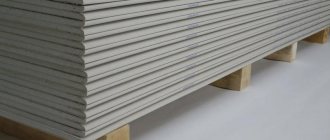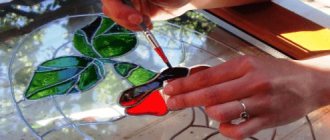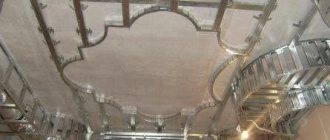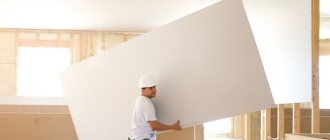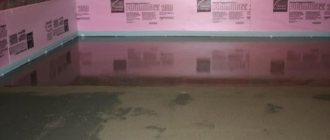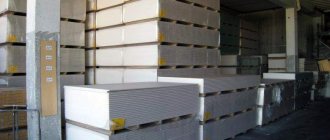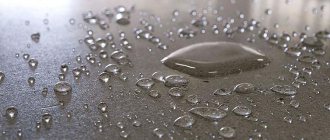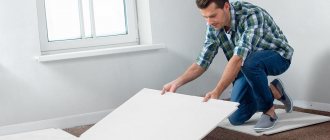Drywall is a building material for wall finishing. Sheets of this material are used for repairing residential and work premises. Recently, the volume of consumption of gypsum boards has fallen slightly, but the product continues to be popular. It is bought by both construction organizations and ordinary people.
There is a demand in the market for inexpensive building materials, so the production of drywall is a promising business. In this material we will tell you in more detail how to open a small factory for the production of gypsum boards, and we will give approximate calculations of the return on investment.
1. Overview of the gypsum board market 2. Areas of application of building materials 3. Types of drywall 4. Initial costs 5. Documents 6. Drywall production technology 7. Premises 8. Raw materials 9. Equipment for the production of drywall 10. Sales of finished products, target audience 11. Profitability and payback: financial plan
GCR market overview
Due to the stagnation in the Russian economy, the size of the plasterboard market is shrinking. According to recent studies, there has been a decline over the past 3 years. Consumption of gypsum boards (plasterboard sheets) has returned to the level of 10 years ago.
In 2016, consumption decreased by 6% compared to the previous year, amounting to 220 million square meters. m, plasterboard production volume – by 4%. At the same time, the dynamics are such that, against the backdrop of a decrease in consumption in the Russian Federation, exports to other countries are increasing.
This situation is associated with a decrease in construction volumes in the country. Construction companies are the main consumers of the material.
However, there is unmet demand, especially in regions where there is no open production of plasterboard sheets. It is definitely advisable to start a business here.
Brand history
1933
Gyproc Products LTD was founded in England near Rochester. Over the 11 years of its existence, the company has become one of the leading manufacturers in the English market and continued its expansion onto the continent, taking a leading position in the Scandinavian countries.
1944
Gyproc Products LTD was acquired by its main competitor - the BPB (British Plaster Board) company, which for several decades became the world leader in the gypsum construction industry, represented by several brands, including the GYPROC brand.
2005
BPB merged with the Saint-Gobain group of companies, which became a new page in the history of GYPROC.
Currently, the brand is actively present in 21 countries around the world and is the highest priority in terms of business development for the Gypsum Division.
Areas of application of building materials
Drywall is most often used in finishing work. GKL is a building material that allows for simple repairs; it is suitable for leveling any surface. With the help of plasterboard sheets, you can flawlessly finish the walls in any room - residential or office.
Wallpaper can be glued onto this building material without any pre-treatment, and pipes, cables and wiring can be hidden under it. Laminated and non-laminated (painted) drywall is used in interior design.
Other areas of application of the material:
- creation of multi-tiered ceiling structures (suspended ceilings);
- production of partitions, columns and arches that do not bear load;
- creating niches and recesses.
"Knauf gypsum Chelyabinsk", Chelyabinsk
The company was built on imported equipment (contract with the Federal Republic of Germany). The company is located in the city of Chelyabinsk, in its industrial zone. There are convenient access roads near the enterprise and the company itself is located near the railway station, which ensures uninterrupted supply of products and delivery of raw materials.
In 1985, it produced a pilot batch of gypsum fiber sheets, and in 1989, it brought the production of gypsum fiber sheets to its design capacity.
The company produces high-quality building materials for the reconstruction and construction of social facilities and housing: dry building mixtures (putty, adhesive and plaster), gypsum fiber sheets.
The Knauf company began operating at the enterprise in 1997. The plant’s employees, together with Knauf specialists, conducted an in-depth technical analysis of the enterprise’s activities and outlined an investment program. Thanks to the joint efforts of German and Russian specialists, the production reconstruction program was successfully completed and the quality of the products was improved.
supplies its products to many regions of Russia: the Far East, the Urals, Siberia and others.
Types of drywall
Production technology allows you to create sheets of any size and area. As a rule, sheets with the following dimensions are used: length - no more than 2500 mm, thickness - 1200-1300 mm, thickness - 8-24 mm.
Table 1. Types of drywall.
| View | Main characteristics | Marking |
| Regular (gypsum plasterboard) | Retains properties at air humidity up to 70% | Gray color, blue markings |
| Moisture resistant (GKLV) | Withstands humidity levels up to 85%, contains silicone granules and antifungal components | Green with blue markings |
| Fire resistant (GKLO) | Has increased resistance to open flame, which is achieved through fiberglass reinforcement | Gray color with red markings |
| Moisture-resistant (GKLVO) | Combines the properties of GKLV and GKLO | Green with red markings |
Important information
Drywall should be purchased strictly for its intended purpose. For example, if you are going to tile a bathroom, then you need to buy moisture-resistant plasterboard. If there is a room in which there is a risk of fire, then it is fire resistant. An ordinary room, without moisture and the risk of fire, can be lined with any type of plasterboard.
Also pay attention to the thickness of the sheet - it is recommended to install thinner models in residential premises, but thicker and more durable sheets in domestic and industrial buildings.
Start-up costs
The main expense item when organizing the production of conventional drywall is the purchase of a production line. In order for an enterprise to remain operational, it must be provided with raw materials. A drywall plant must store sufficient raw materials.
Table 2. The amount of initial costs for the production of drywall.
| Expense item | Cost, rub. |
| Registration, certification | 40 thousand |
| Premises for rent, 500 sq. m | 250 thousand |
| Machine tools | 9 million |
| Raw materials (per month) | 500 rub. |
| Salary, 13 people. | 350 thousand |
| Additional expenses | 150 thousand |
| Total | 10.29 million |
The calculations are relevant for a city with a population of up to 1 million people. Additional expenses include expenses for utilities, advertising, and cosmetic repairs.
Documentation
An entrepreneur can conduct business in the form of an individual or legal entity. However, an individual entrepreneur will not be able to build a large distribution network or cooperate with wholesalers and construction companies. Therefore, it is best to open an LLC - the simplest form of legal entity. faces.
The documents indicate OKVED code 23.62 “Production of gypsum products for use in construction.”
Although it is not necessary to obtain a mandatory quality certificate for drywall, it is still recommended to undergo voluntary certification according to the GOST R system. 98% of Russian manufacturers have a similar document that guarantees the proper quality of the product. The certificate will help you quickly agree with intermediaries on supplies and improve sales.
Drywall production technology
The production of conventional drywall consists of the following steps:
- A mixture of the desired composition is created. Various admixtures are added to the solution to improve the characteristics of the building material.
- On a conveyor belt, gypsum sheets are created, which are fed into a special former, where the sheets are glued together and the web is formed.
- The “semi-finished product” is fed to a conveyor belt, where the web is formed according to the laid down program and profile sizes.
- On a roller conveyor container, the fabric is cut using guillotines.
- The resulting sheets are transported through the device to a cantilever conveyor, which lays them out for drying.
- GKL are processed in a dryer for at least 1 hour until completely dry.
- The sheets are transferred to an additional roller conveyor where they are cut.
- The finished product is stacked and packaged.
The production technology can be seen in the following video:
Room
To organize a plant for the production of plasterboard sheets, you will need a fairly large area - at least 500 square meters. m. Most of the territory will be occupied by a workshop and warehouses. A room for workers, a bathroom, and an administrative office should be equipped.
It is necessary to install an industrial electrical network, water supply and sewerage, as well as heating. The air temperature in the workshop should not fall below 15ºС.
Near the plant it is necessary to provide access for trucks and a place for loading and unloading operations.
It is best to localize the premises for the production of drywall in an industrial area or on the outskirts of the city - that is, in accordance with the requirements of the standards and close enough to the sales market.
Raw materials
The main raw material is gypsum. It can be either natural or artificial. But it must be taken into account that artificial gypsum - boron or phosphogypsum - is obtained from waste from the chemical industry. It will need to be additionally purified from impurities, which involves additional expenses.
Cardboard is needed for cladding; it is placed on both sides of the sheet blank.
The materials of the next group are needed to create sludge and a mixture for pouring. We are talking about a synthetic foaming agent, modified starch, casein, cellulose, table salt, caustic soda and water.
A number of impurities can be added to the mixture to improve the characteristics of the product - glass fiber, silicone granules, lignosulfonates.
Equipment for the production of plasterboard
Using production lines of the GKL-0.2 type, the production of plasterboard sheets will be fully automated. Personnel are needed only to maintain production equipment.
The line consists of:
- devices for forming a mixture of gypsum;
- a conveyor that ensures the movement of the product through all stages of drywall production;
- former, necessary for forming the web and gluing sheets;
- a belt conveyor that ensures that the sheet exactly matches the required dimensions;
- roller conveyor and additional roller conveyor for cutting and trimming the product;
- console and drying conveyor - for drying gypsum boards.
The cost of such a line with a capacity of up to 200 sheets per day is 8.5 million rubles. Taking into account the costs of delivery and installation - approximately 9 million rubles.
Accessories, components and additional materials for cladding gypsum board walls
When performing wall cladding work, you will need additional materials, without which high-quality installation is simply impossible. Each manufacturer has technological maps that indicate fittings, recommended building mixtures and additional items such as damper tape or sickle tape.
- Metallic profile
If gypsum board sheets are not glued directly to the wall, they will be required to construct lathing. It is also used in the construction of partitions, arches and other complex structures. There are two types of profiles, guide and rack. A rack profile is inserted into the guide profile, thus forming the skeleton of the structure.
The rack profile, in turn, is divided into ceiling (lighter and narrower) and wall. The wall profile must have a thickness of at least 0.6 mm, and a U-shaped geometry with stiffeners.
For ceiling lathing, it is allowed to use a profile with a thickness of 0.3 mm or 0.6 mm. A thin-walled profile significantly facilitates the design, but has a significant drawback - in a thin profile, the screws can scroll, which means they are not completely recessed into the thickness of the sheet, which will complicate subsequent finishing.
In addition to the profile, a wide range of accessories is also produced in the form of profile connectors and hangers.
- Damper tape.
Strip made of polyurethane foam. During installation, it is laid between the profile and the wall, and in the places where the profile adjoins the floor and ceiling. This is done so that vibration from the floor and ceiling is not transmitted to the sheets and metal profiles.
- Serpyanka.
Synthetic mesh tape for sealing seams, joints or junctions between slabs and floors or ceilings. Sold in rolls of different widths and densities. Tape reinforcement helps avoid cracks at the joints of the sheets.
- Self-tapping screws.
Required for attaching a gypsum board sheet to a metal profile.
- Construction mixtures for sealing bayonets and seams.
Available in ready-made form (packaged in buckets and ready for use), and in dry form for preparing the mixture yourself.
- Tools for work.
The required minimum is:
- Roulette.
- Pencil.
- Stationery knife.
- Bubble or laser level.
- Screwdriver and hammer drill.
- Spatulas for working with seams.
In addition to this list, we recommend metal scissors for cutting profiles, a cutter for connecting profiles without using self-tapping screws, and an edge plane for processing the ends of drywall sheets.
Sales of finished products, target audience
Consumers of drywall are construction and repair organizations, specialized stores and individuals who need plasterboards for domestic needs.
Sales can be organized either directly or through intermediaries. In the first case, it is assumed to work with construction companies and/or open your own retail store, in the second - supplying consignments of goods to wholesale and retail chains.
The businessman himself or the sales manager can conduct negotiations with counterparties and conclude contracts.
The drywall market is filled with products from several large companies), so to attract buyers, you should first offer your product at low prices. The best option is to enter into long-term contracts with one or more customers, to whom you sell most of your sheets.
"Lafarge"
"Lafarge" - this French company has set one of the lowest prices for plasterboard products compared to other brands. This is explained by the fact that it has the largest number of production facilities around the world. Quantity does not harm quality and they produce only high quality products. This company is distinguished by the fact that it pays special attention to the processing of sheet edges, which makes the product perfectly smooth.
See also: How to choose siding for cladding a house - the main selection criteria Lafarge drywall

